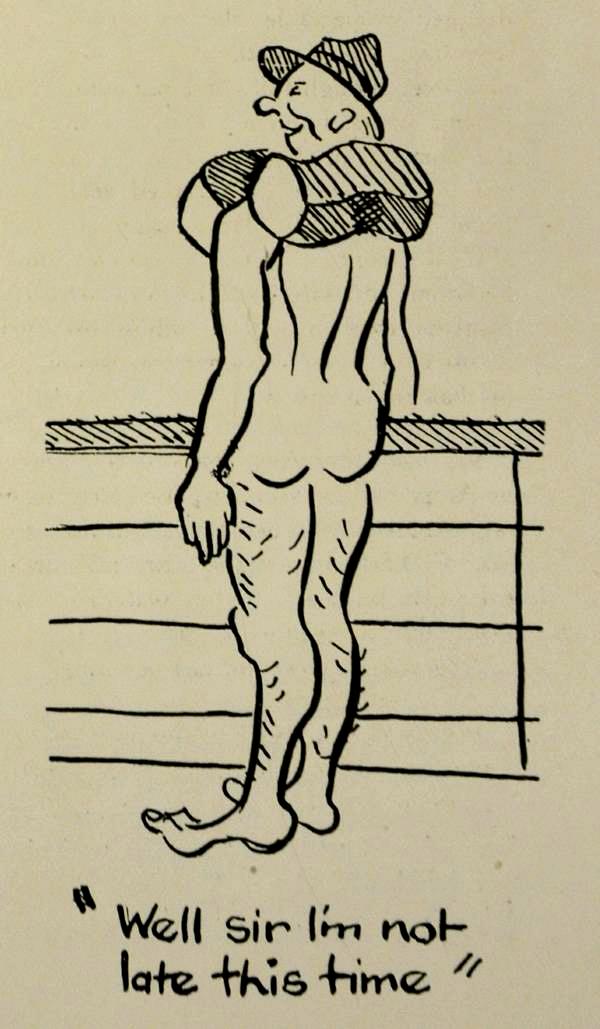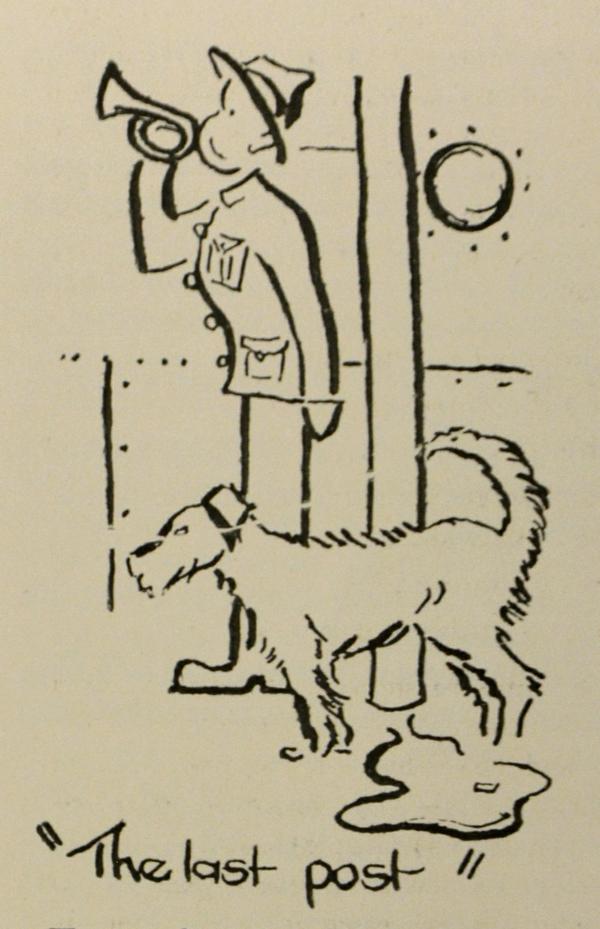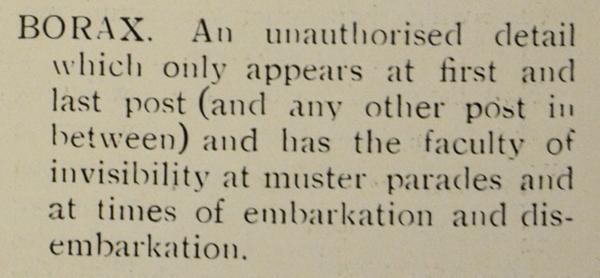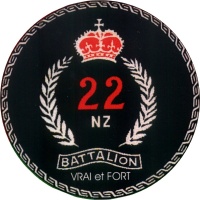
22nd Battalion 2NZEF
"Vrai et Fort"
"Borax" - the Battalion Mascot
"Borax", a small black and white fox terrier, was adopted by A Company, 22 Battalion after he was left behind in Trentham when the men of his earlier posting embarked overseas. When the 22 Battalion sailed on 2 May 1940, Borax was smuggled
aboard but was found the next day. As the Official History records, he accompanied the Battalion to England where he continued to present himself in full uniform and often turned out on parades.
And apart from two photographs, that has been the extent of the information available on Borax. How did he get on board the X3 Transport? Who looked after him, and what happened when the Battalion was shipped out to Greece?
Who did Borax serve with in Trentham?
News reports (see below) claimed he was abandoned by 19 Battalion when they embarked for overseas on 4 January 1940. This does noI appear to be correct. Here is why.
The 19 Battalion Official History has a photo of the officers at Trentham with a dog and this may be the source of the rumour. As the photo shows, the dog clearly is NOT Borax - and was named "Major". However the Divisional Signals History has
a photo of its officers (taken at the same time as the 19 Battalion photo) and this has a black and white terrier that is identical to Borax, but unfortunately not named.
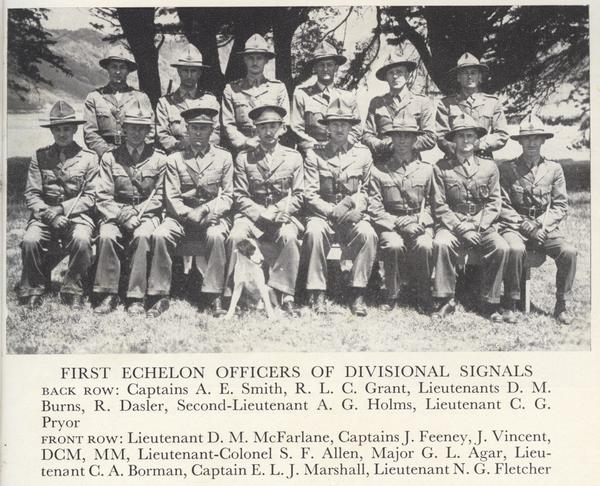 Official photo of the Officers of Divisional Signals with Borax. Official photo of the Officers of Divisional Signals with Borax.
Click on photos for larger version.)
|
|
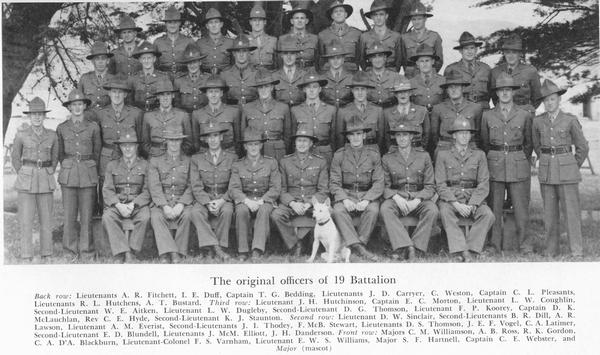 Official photo of the Officers of 19 Battalion with "Major". Official photo of the Officers of 19 Battalion with "Major".
|
|
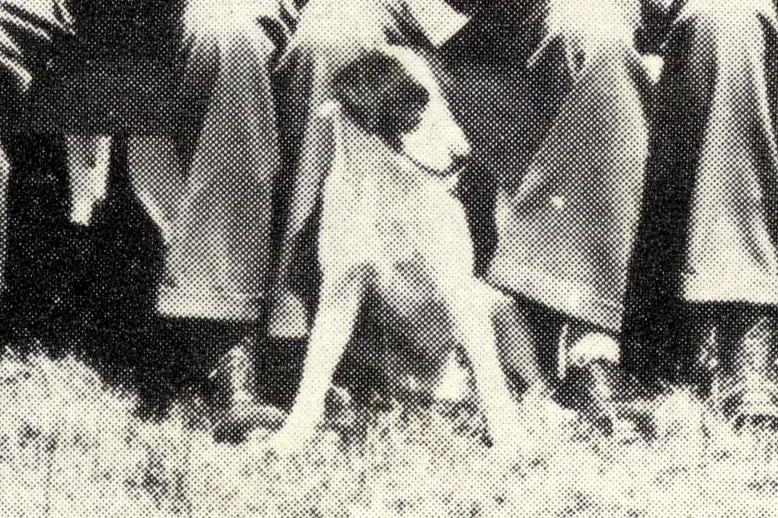 Div. Signals mascot - "Borax" Div. Signals mascot - "Borax"
|
|
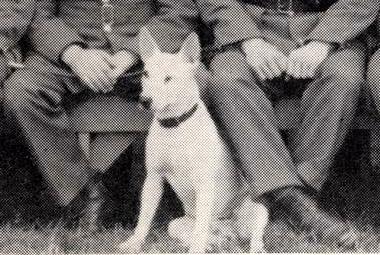 19 Battalion mascot - "Major" 19 Battalion mascot - "Major"
|
|
In addition, one of the Div. Sigs. officers (2nd Lieutenant A.G. HOLMS - brother of Ian HOLMS - the 22nd Battalion's first casualty) retained a newspaper cutting of Borax in England and wrote on it - "He was Our Dog."
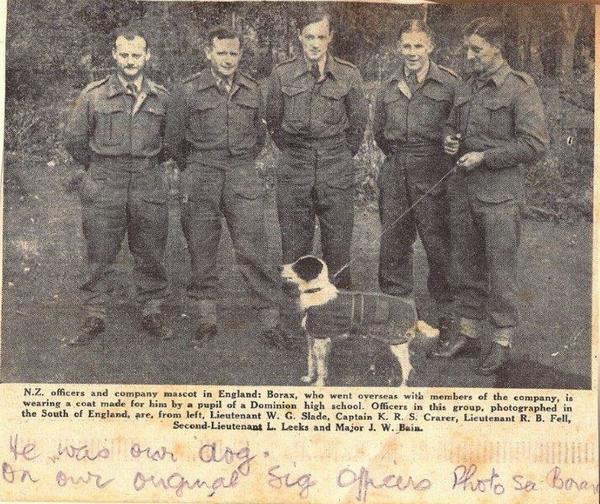 Newspaper cutting (possibly from the "Dominion" in Wellington) showing Borax in England (see photo below taken by Lt Fell for comparison) on which Lt Holms has written
"He was our dog". (Clipping supplied by the Holms family.) Newspaper cutting (possibly from the "Dominion" in Wellington) showing Borax in England (see photo below taken by Lt Fell for comparison) on which Lt Holms has written
"He was our dog". (Clipping supplied by the Holms family.)
|
The Story of Borax
As retold by Tired Terry (aka Sir Terence Power McLean)
Many of the "originals" would have known the story. Only Terry McLean the journalist ("Tired Terry" to the men) wrote it down. Here is Terry's telling of the story. His
manuscript is amongst his papers, lodged in the Alexander Turnbull Library.
Towards the end of January 1940, an unexpected recruit posted himself to the battalion. Someone instantly called him “Borax”.
He was a semi-fox terrier who was only a little cross-eyed and only a little lovable. He would not yield to caress and he
made his home where he pleased, without distinction as to company or platoon. He had enormous, eccentric skill as a cricket
fielder, catching a ball in the air with gigantic, convulsive leaps and snapping up a rolling one off the ground with the
skill of genius. Borax trained hard for the cricket held in the sports periods on Wednesday afternoons. At any hour of the
day or night he would catch stones flung for him by the soldiers and he would even swallow the small ones if others were
thrown too quickly in gestures disparaging to his skill. No one had thought of a Borax for the Battalion. Within a few days,
no one doubted that he must stay. His piercingly stigmatic glance into nothingness, his crankiness of temperament, his marvellous
skill with a ball or stone, these and many other things about him were engaging. In any case, Borax had a mind of his own. He
had apparently decided to stay and that, for the time being, was the end of the matter.
The whispers of a sailing date sounded through the battalion like the rustling of leaves in a wind. The authorised marking of
clothes pointed the date. Vaccination made certain the time could not be far away. And the publication of an order relating to a
State reception and a farewell march through the streets of Wellington on 27 April clinched the accuracy of the rumour that the
departure would be about the end of the month.
The general excitement affected the workings of the committee self-appointed to protect the interests of Borax. Soon after return
from final leave, the committee had addressed a notably respectful request for permission to take the dog overseas. The request
had been declined and the committee, “in committee”, after expressing its disapproval of the reply in the strongest terms,
determined upon ways and means. In pursuance of these, Pte Booth and comrades of A Coy acquired an extra kitbag from the QM
store and at odd times practised the off manoeuvre of securing Borax in the bag, with just his nose showing, and carrying him up
and down a ladder placed against the boiler house. Borax never wanted in intelligence and he soon caught on, but he was not quite
well-bred enough to conceal a look of utter desolation and disgust whenever he saw Booth and his henchmen arranging another
practice, down behind the showers.
On the morning of Sunday 28 Apr, an advance party headed by the Colonel departed for the ship.
The excitement soon became frantic. Kitbags were stacked for the baggage party. The battalion paraded. The wait, as always,
was long. The transport, according to the Army, was the X3. It soon proved to be more exciting than the dry nomenclature suggested.
It was the Canadian Pacific liner, Empress of Britain, of 43,000 tons, one of the largest and most luxurious liners in the world.
Even Lt Lovie, a Great War veteran whose invariable reply to complaints had been “You ain’t seen nothing yet!” was silenced
by a size and quality of transport undreamed of by soldiers of the First World War.
The battalion filed silently aboard. Borax was put in his bag and carried up the gangway and not a member of the
embarkation staff thought anything was amiss. The Empress of Britain pulled away from the wharf on the following morning,
Thursday 2 May, and that afternoon sailed from the harbour. The strength of the Battalion was 756 all ranks. The total
included 41 officers, eight warrant officers, 44 sergeants and 663 other ranks (and one dog).
On the first day out, the ineffable Borax was the cause of trouble. “The soldier or soldiers responsible for
bringing on board the dog commonly known as “Borax” “, as Routine Orders phrased it, was ordered to report to
unit headquarters. After wresting with his conscience for some time, Pte Booth at last confessed the hideous deed.
Business with Borax it seemed, was gratifyingly brisk. Booth’s confession was the third on the list. Two sergeants had
forestalled him with categoric confessions. There was some speculation about the motives of the sergeants. At any rate,
plethora of confessions or not, Borax was arrested. Authority was pleased to be stern and Brutus-like in reaction to the
first tentative requests for the dog’s release. Authority having been proved there was yielding in the granite and Borax
at last was freed. He roamed the ship perfectly happy after that.
August 1940 – Britain
On 12 and 13 August, some of the first severe fights in the Battle of Britain were staged above Aldershot and over the Channel.
At 0115 hrs on 16 August a raider bombed Mytchett and in the afternoon of the same day seven enemy planes, thought at first
to be an RAF formation, dropped bombs about two miles from the camp and machine-gunned the streets of North Camp.
Captain Monk, the adjutant, was taking a shower when the planes appeared. He sped naked for a slit trench.
Diving for cover had become a serious occupation and Borax was not least in the unit in skill. It was possible to tell
where he was. Loud and lurid language told, plainly enough, that Borax was happily at work, digging for rats or snuffing
about the head of a soldier. Nothing seemed to shake Borax’s belief that even the shoddiest slit trench was a place of romance.
December 1940
Borax had never been much out of the news. He had been made a member of the Tailwaggers’ Club of Great Britain (site opens in new window)
and a gentleman connected with the New York World’s Fair took the trouble to enquire about him. The girls of the Hutt
Valley High School in Wellington made a blanket cover for him for the English winter and Borax acknowledged
its receipt with the cable, “Many thanks. Yelps. Borax.” A Camberley veterinary surgeon pronounced him fit,
though worn in the tooth from too much chewing of stone, and Pte Lindsay was gratifyingly discussing the circumstances
with a friend within the observation of his Coy Commander. Later, there was a good deal of explaining done about
reasons for being in town without a leave pass.
Borax had come to mean a good deal to the battalion. His fate was strange and uncertain. When it became known that the
unit was to go to Egypt, it was decided to leave him in England because of the unsuitability of the desert climate.
On 26 Dec, he was posted to a rear party which comprised men who had been graded out of the battalion for medical reasons.
Borax left the party not long afterward for the purpose, it was surmised, of finding his way back to the unit. He was not seen again.
|
Borax on the High Seas
Borax became a well-known identity during the long voyage from Wellington to Britain. He was mentioned in letters home, such as by LT Ed McAra:
|
4 May 1940: "A nondescript fox terrier, commonly known as "Borax” in Trentham, appeared on deck this morning, having been smuggled
aboard in a kit-bag. In an attempt to win official status, he wore a canvas cover with scarlet infantry patches, and the legend -
"Borax, A. Coy., 22nd. Bn.”
16 May 1940 "One amusing sketch drawn for the ship’s magazine showed a beaming soldier, nude from the shower save for his belt,
saying "I made it this time, sir!” Another good one showed the ship’s bugler blowing "Lights Out" beside a stanchion, while alongside
stood “Borax” in a suspicious pool - the title being "The Last Post!"
|
|
|
|
Borax also had his own definition in the ship-board magazine "BoraX3":
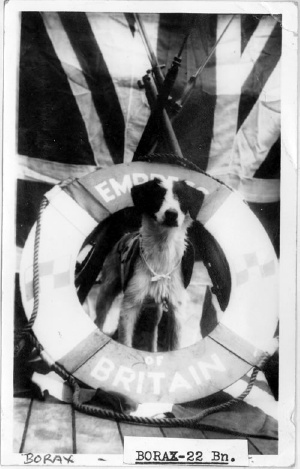 Borax on the ship "Empress of Britain" en route to England, May 1940. Borax on the ship "Empress of Britain" en route to England, May 1940.
From the de Lisle collection. See nzhistory.net.nz
|
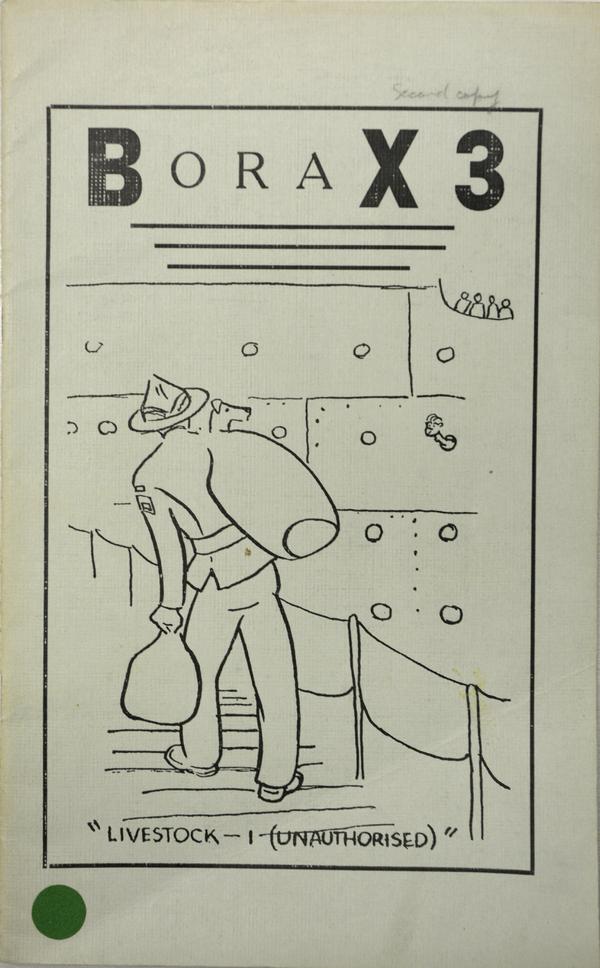 After being discovered onboard the "Empress of Britain" (convoy X3) Borax lent his name to the shipboard magazine. After being discovered onboard the "Empress of Britain" (convoy X3) Borax lent his name to the shipboard magazine.
|
Borax on parade in his official uniform
Borax often turned out on parade with the Battalion as these photos record. His parade uniform was made for him by the girls at Hutt Valley High School. Apparently the uniform survived the war, being passed on to Haddon Donald at the 1995 National
Reunion by Doug Caldwell. Haddon Donald subsequently offered it to the Waiouru Army Museum. The Museum replied that they would like the dog's cover, but on inquiring there in 2023 I was told they have no record of it. I wonder what it has been recorded under,
or maybe disposed of by a person who did not understand it's significance?
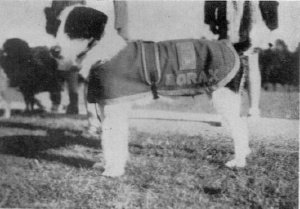 Borax on parade in England Borax on parade in England
resplendent in the cover made for him by the girls of Hutt Valley High School, Wellington
|
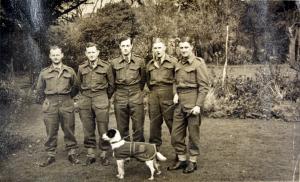 Borax in Britain Borax in Britain
Compare to photo in newspaper clipping above.
This photo by 5943 Fell, R.B. Died Crete 20 May 1941. File MS-Papers-1575, Alexander Turnbull Library Wellington
|
Borax in the News
Smuggling Borax onboard a troop ship and then winning the (grudging) approval of the commanders made a fantastic news story. Soon after the Battalion arrived in Britain Borax hit the headlines in New Zealand. Here are two examples"
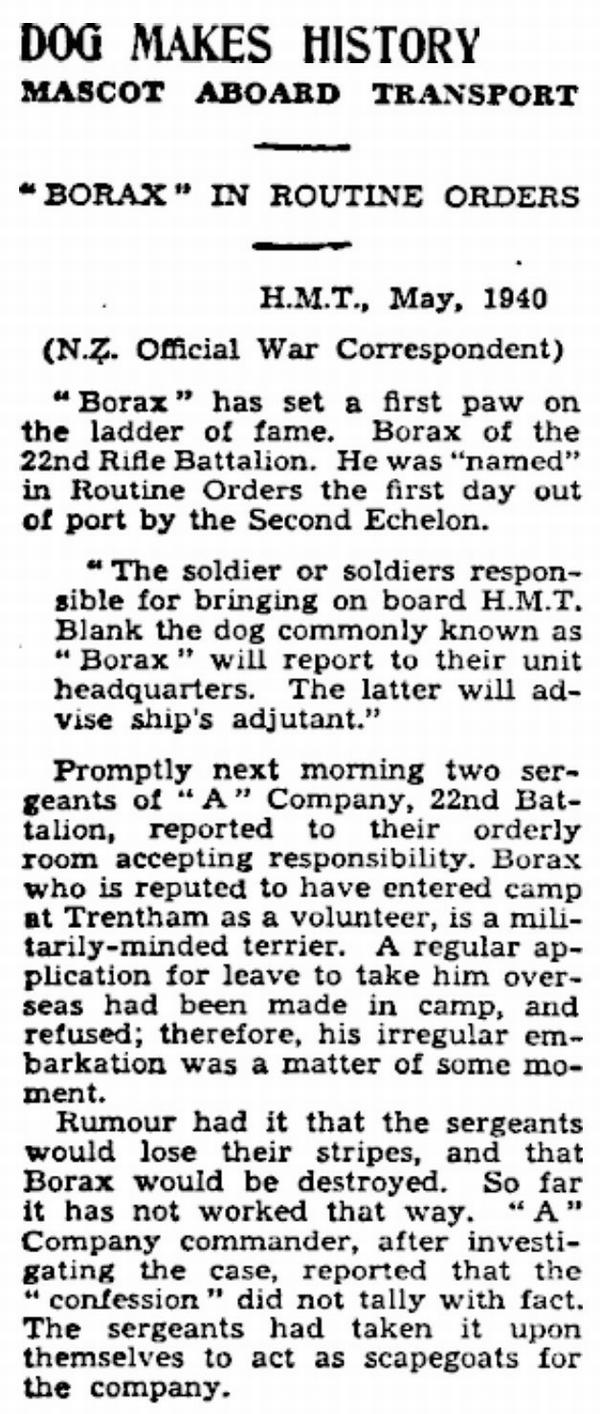
|
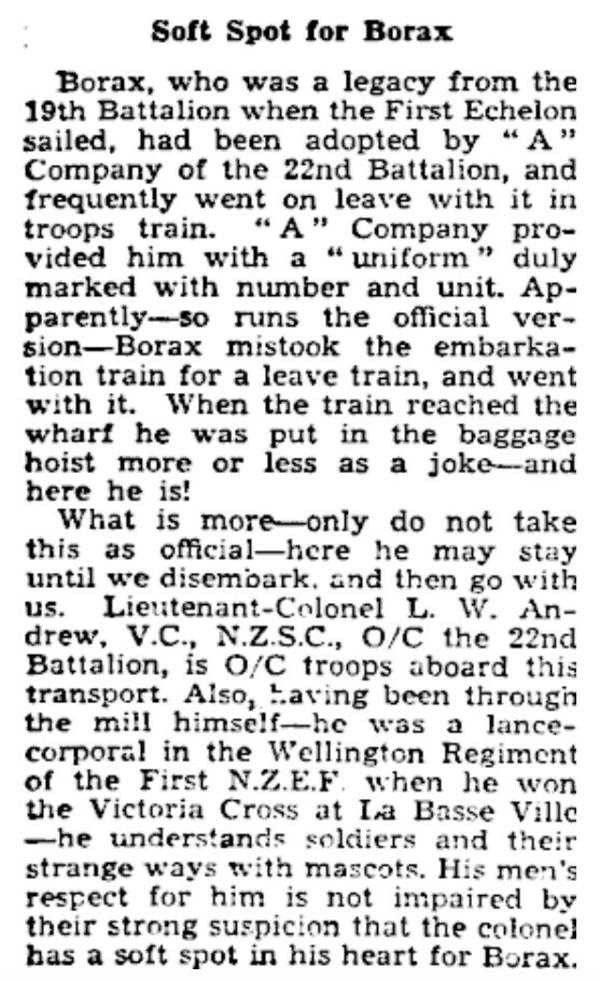
WAIKATO TIMES, VOLUME 127, ISSUE 21145, 21 JUNE 1940, PAGE 9. From National Library Paperspast
|
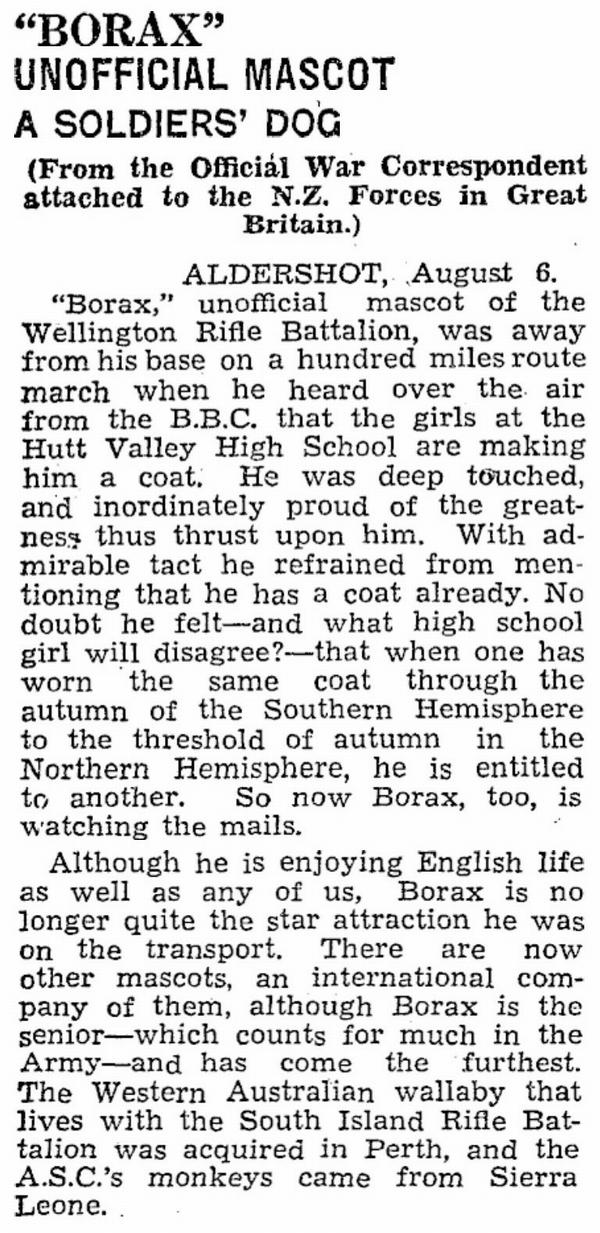
EVENING POST, VOLUME CXXX, ISSUE 59, 6 SEPTEMBER 1940, PAGE 5.
|
Borax sent home
The Official History refers to Borax on Page 9, but does not mention what
happened to him when the Battalion embarked for Egypt in early January 1941.
However, the answer lies in the Routine Orders of the Battalion. RO43, for 21 December 1941 states:

RO43 for 21 December 1940 |
Returnto Index
Last updated: 19 September 2024
|






